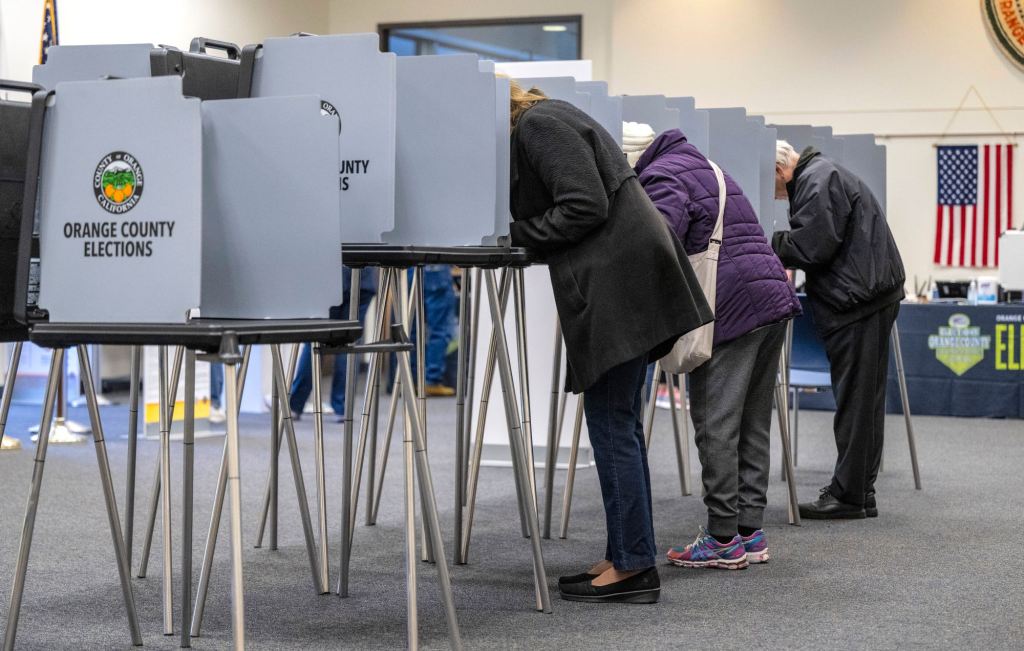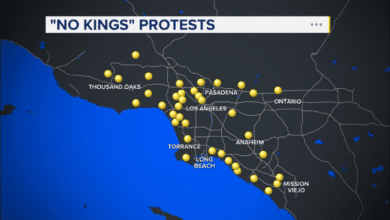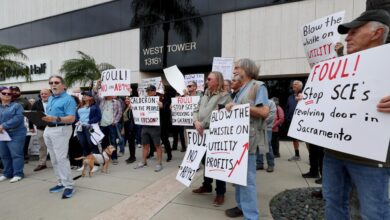Among 26 Southern California congressional districts, demographic data shows differences, similarities – Orange County Register

Most elections boil down to two groups, candidates and voters.
And in most elections you typically hear a lot about one of those groups, the candidates. Candidate views, candidate histories, candidate promises and, alas, candidate whoppers.
But information about voters isn’t as robust. Sure, there’s a lot of man-or-woman-in-the-street data about why a particular voter loves or hates a particular candidate or idea. But bigger-picture reports about how demographics align with politics – information that might explain why voters behave the way they do – are rare. Campaign consultants swim in that stuff but it’s not typically explored in public.
That’s what makes a recent spate of data dumps – from the Public Policy Institute of California, the California Secretary of State and the Census Bureau – so interesting.
Since June, all three groups (the Public Policy Institute of California is a nonprofit; the California Secretary of State and the Census Bureau are government agencies) have issued reports about state and/or national congressional districts, including the 26 House seats that are entirely or partly in Los Angeles, Orange, Riverside and San Bernardino counties.
But while each report offers some detail about the demographics in those 26 districts, the real value comes when you combine some elements from all three. The blended data, which includes some seemingly arcane details about the roughly 700,000 to 800,000 people who live in each of those districts, tells a story about Southern California politics that often defies conventional thinking.
For one thing, the numbers suggest there is no such thing as “Southern California politics.”
In fact, demographic data shows that the region’s 26 congressional communities diverge – often wildly – from each other.
For example, people in the wealthiest of the local seats, California’s 36th congressional district, which runs from Beverly Hills to Palos Verdes, earn a median household income of $129,277, more than double the median household income ($62,008) earned in the region’s poorest House seat, CA 34, which covers east Los Angeles.
Geographically, those two seats are within 15 miles of each other. Financially, they could be on different planets.
Yet, politically, they’re mirrors. Both seats are among the most reliably Democratic House seats in the country, something that’s true for much (though not all) of the region.
“Maybe how much you make isn’t as important as everybody thinks,” said Yolanda Espinosa, a Boyle Heights resident who this election season is knocking on doors to urge people in her community to vote for Vice President Kamala Harris.
“Maybe other things matter.”
Maybe they do.
With that in mind, here’s what data on some of those “other things” reveals about voter communities in Southern California’s congressional districts.
Age divides
House seats are redrawn every 10 years to ensure that specific interest groups – often defined by people of the same race or ethnicity – have the political clout to attain their supposedly shared interests. That’s fine as far as it goes, but it leaves out some big-picture demographic factors – education, health, money – that also can define common interests and also can drive voting behavior.
Those unconsidered factors are what make Southern California’s 26 congressional communities as diverse from each other as they are.
Take age. In theory, people living in one House seat shouldn’t be much older or younger than the people living in a nearby House seat. Census data suggests that’s true in many states; in Nebraska, Nevada, Idaho and Washington, among others, the median age of the people living in their House districts varies by only three to five years.
Not so in Southern California. The gap between the youngest and oldest local House seats is nearly 10 years. In CA 39, which includes parts of Riverside, Moreno Valley and Perris, that median age is 33.2 years; in CA 28, which covers parts of Pasadena and Rancho Cucamonga, it’s 43.
That age gap isn’t trivial. Polling consistently shows that opinions on a range of issues – federal support for child care, student debt forgiveness, Social Security – can be linked to a voter’s age. Critically, because older people tend to actually cast ballots, while younger people often don’t, any age gap between House seats could translate into more or less political clout.
But at least some younger voters in the state’s 39th congressional district don’t think that’s how it’s going to play out in November.
“The ‘go vote’ and ‘go register’ stuff on my TikTok is, like, constant,” said Chase DeCarlo, a 26-year-old who lives in Riverside. “Now, that might be coming into my feed because I voted already and I’m registered, but I’m guessing a lot of people my age are getting the same message.
“I bet turnout for (my generation) will be pretty good this time,” he added.
DeCarlo says his biggest political issue is climate and environment. Though polling suggests environment resonates more with younger voters than it does with older voters, DeCarlo again thinks the polling might be off.
“My grandfather was a hunter and he fished and stuff. He camped. He cared a lot about the environment,” DeCarlo said.
“He’s dead,” DeCarlo added. “But I’m pretty sure if he weren’t he and I probably would vote the same way on that.”
Education and immigration
Another demographic trait that varies wildly within Southern California’s congressional communities is education.
In the region’s most highly educated House seat, CA 36, nearly 68% of all voters over age 25 have a college degree or higher, while about 4% never finished high school. That contrasts sharply from the region’s least-educated House seat, CA 25, which includes parts of Beaumont, Banning and Coachella, and where about 18% of adult voters have a college degree or more and nearly 1 in 4 (24%) don’t have a high school diploma.
The differences aren’t always as stark, but similar numbers dot the Southern California political landscape.
No fewer than 14 local House seats rank higher than the national average (10.2%) for voters with no high school diplomas. Meanwhile, eight local seats rank higher than the national average (37.7%) for voters with a college degree or higher, including several (CA 30, CA 32, CA 40 and CA 47) where college grads account for between 50% and 60% of the potential electorate.
Two seats – CA 26, which touches parts of Thousand Oaks, Oxnard and Calabasas, and CA 28, which runs from part of Pasadena to part of Rancho Cucamonga – beat the national averages for both sides of the educational attainment category.
And, like age, education is potentially important. The so-called “diploma divide” – the differences in voting behavior between people with and without college degrees – is now the single biggest factor in predicting how a person will vote. In 2020, former Vice President Joe Biden beat then-President Donald Trump by 13 points among voters with a college degree, while Trump beat Biden by 19 points among people without a degree.
But it’s unclear how powerful the diploma divide is in Southern California.
Recent voting results and anecdotal evidence suggests that college students currently do favor Democrats, hinting that diplomas could lead to left-of-center voting.
“Our campus had a huge Democratic club,” said 29-year-old Adam Wendell, a recent UCLA graduate who lives in south Orange County.
“It had an active GOP club, too, but they weren’t as visible or popular as the other guys.”
But Wendell, who says he leans conservative and hopes to break into advertising, said he learned “from my classes at UCLA” that what happens on campus, politically, might stay on campus, at least over the long haul. He believes lifetime political affiliation can be as pliable as a shopper’s preference for a particular car brand.
“It could change,” he said. “Over time, it could definitely change.”
Some data suggests Southern California is already bucking the diploma divide.
Among the five local House seats with the highest rate of college grads, only three currently have more registered Democrats than Republicans, and the Democratic advantage in those three seats averages about 21 points. (The GOP lean in the two seats that favor Republicans is 2.5 points). And among the five Southern California districts with the most voters who didn’t finish high school, all five favor Democrats by an average of 28 points.
There’s another area in which Southern California bucks – or, rather, exceeds – national trends: immigrant voters.
Nationally, 13.8% of all Americans were born in another country, according to the latest census. And, according to models from Pew Research, about 9.9% of all eligible voters in 2022 were people born in another country.
Those numbers are dwarfed locally.
Every one of the 26 House seats regionally has more foreign-born residents than the national average. In districts as economically and racially diverse as CA 34 in East Los Angeles, or CA 29, which covers Sylmar and Toluca Lake, or CA 45, which includes the Little Saigon district in Westminster and Garden Grove, about 4 in 10 residents came from other countries.
And while no model shows exactly how that has translated into actual voters, locally, the numbers suggest the Southern California electorate is far more influenced by foreign-born voters than what is typical across the country.
Political volunteer Espinosa, who was born in Mexico and usually speaks Spanish while urging her neighbors to vote, noted that foreign-born voters are “fundamentally American.”
“Some people don’t like it, I guess. But they should look at their history. Everybody comes here from somewhere. Then they become American. And then they vote.
“It’s an old cycle.”
Guess who isn’t weird
The political debate this election year includes a lot of California bashing. Just last month, Trump spoke at his golf course in Rancho Palos Verdes and described California as “failing,” which he attributed to the state’s liberal political bent.
The idea didn’t originate with Trump, and it’s been a trope for conservative political candidates of all stripes. Even former California Gov. Ronald Regan used the basic idea during his successful bid to win the presidency in 1980.
Mike Madrid, a former GOP campaign consultant who now leads the anti-Trump Lincoln Project, told the Washington Post last month that painting California as an outlier plays well with voters around the country.
“Attacking California is attacking more than just a geographic place,” he said. “It’s attacking a set of cultural values.”
If so, data on local House seats suggests those cultural values emerge from economic conditions that, contrary to reputation, are often in line with the rest of the country. Though Southern California often is portrayed as a place of outsized wealth and outsized expenses, the actual numbers don’t always back that up.
The median household income nationally is $80,610, and in nine House seats in Southern California the median income falls within 10% of that figure. The median monthly mortgage payment, nationally, is $2,617 and 10 local House seats fall within 10% of that figure.
Rent expenses? Disabled populations? Child poverty? Again, in all of those economic and health measures, about a third of the region falls in line with the rest of the country. If Southern California is politically weird, as some suggest, it’s not because of money or health.
“I haven’t been around the country, OK, so maybe I don’t know,” Espinosa said. “But people here, to me, feel like real Americans.”
Originally Published:




